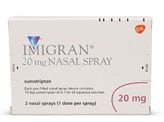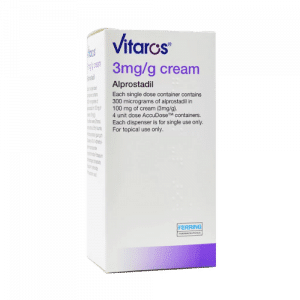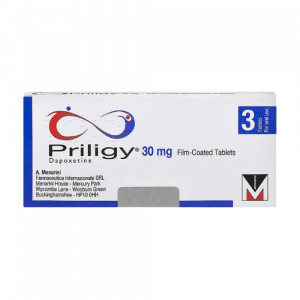
Standard Imigran Nasal Spray, containing the active ingredient sumatriptan, offers rapid relief from migraine headaches. Available in 10mg and 20mg dosages, this nasal spray is designed to reduce the widening of blood vessels in the brain that contribute to migraine symptoms. Ideal for individuals seeking a fast-acting solution to intense headaches, nausea, and sensitivity to light or sound. Sumatriptan works by targeting the root cause of migraines, providing relief often within minutes of application. Begin your online consultation today to explore if Standard Imigran Nasal Spray is suitable for your migraine management plan.
Standard Imigran nasal spray
£46.48 – £51.45
Product Information
About Standard Imigran nasal spray
Sprays and tablets
We supply Imigran nasal sprays (10mg & 20mg) and sumatriptan tablets in 50mg and 100mg strengths for the relief of migraines. ‘Sumatriptan’ is the active ingredient in Imigran. Generic sumatriptan tablets cost less than branded Imigran tablets but are medically the same (see generic medicines FAQs page).
How does sumatriptan work?
Migraine occurs when blood vessels in the head widen temporarily. Sumatriptan tablets and nasal sprays reduce the widening of the blood vessels and this helps to relieve headache and other migraine symptoms.
Buying sumatriptan online
Whilst Sumatriptan is available over the counter, it is always recommended to consult your GP to confirm the diagnosis before obtaining supplies of migraine treatment online. Consult your GP if your symptoms are changing or you experience any new medical conditions or side effects. Checks are carried out online, but this does not replace a face-to-face consultation with a doctor.
Who can take sumatriptan?
Imigran is for people who have been diagnosed with migraine, not for other sorts of headaches. Migraine headaches typically are throbbing and severe, and are associated with nausea vomiting, and photophobia (aversion to strong light). They usually are localized to one side of the head, but not always, and are sometimes preceded by symptoms such as flashing lights or other visual or sensory disturbance (aura). They usually last a few hours and then resolve, with no symptoms in between. There are many variants. See the NHS Migraine and NHS Sumatriptan pages for further details.
Who should not use sumatriptan?
Discuss your treatment with your GP and don’t use sumatriptan without approval if any of the following apply:
- A history of fits or seizures.
- Serious liver or kidney disease.
- Over 65 years old.
- If you are a heavy smoker (over 25 cigarettes/day), a man over 40, or a woman past menopause – you may be at extra risk of developing heart disease and may need extra checks from your GP before taking sumatriptan.
- Have had a heart attack, stroke, or mini-strokes (TIAs) in the past.
- Problems with poor circulation (peripheral vascular disease).
- Angina (heart pain on exertion).
- Irregular heart rhythm.
- You have uncontrolled high blood pressure.
Taking sumatriptan with other medicines
Sumatriptan (Imigran) belongs to a group of medicines called triptans, and should not be taken at the same time as other triptans used to treat migraine, including naratriptan, rizatriptan, and zolmitriptan. Other migraine treatments may interact, namely ergotamine or similar medicines. Leave at least 24 hours between taking these medications and sumatriptan. See the ‘other medicines’ section of the manufacturer’s leaflet for further details.
Sumatriptan should not be taken within 2 weeks of MAOIs (monoamine oxidase inhibitors antidepressants) and can interact with other antidepressants known as SSRIs, or SNRIs, and herbal remedies containing St John’s Wort.
Talk to your doctor if you take any antidepressant medication.
Dr Fox checks for interacting medication in the online migraine consultation.
Can sumatriptan be taken during pregnancy and whilst breastfeeding?
There is no evidence of an increased risk of birth defects with sumatriptan in pregnancy, but there is only limited information. The risks and benefits of treatment should be discussed with a doctor before taking sumatriptan in pregnancy.
Even though minimal amounts get into breast milk, manufacturers recommend not to breastfeed or use expressed milk within 12 hours of using sumatriptan.
Further information can be found at BUMPS – Sumatriptan.
Sumatriptan side effects
Serious allergic reactions (rash, hives, wheezing, swollen eyelids and face, and collapse) are very rare, but if they occurred would require immediate medical attention – telephone 999 in the UK.
Do not take sumatriptan if you have a known allergy to other triptans, or to sulphonamide antibiotics (rarely used).
Not all people experience side effects and some symptoms may be caused by the migraine itself.
Common side effects with sumatriptan tablets and Imigran spray (affecting up to 1 in 10 people) may include aching muscles, shortness of breath, dizziness, tiredness, nausea (feeling sick), and a temporary increase in blood pressure.
A common side effect of the nasal spray is an unpleasant taste in the back of the mouth and irritation in the nose and throat.
Other side effects are possible and include seizures, visual disturbance, heart problems (angina, changes in heart rhythm, heart attack), reduced peripheral circulation (cold hands and feet), feeling faint, joint pains, anxiety, and sweating.
A full list can be found in the manufacturer’s patient leaflet.
How to use Imigran nasal spray
It is best to start treatment as soon as you feel a migraine headache coming on, although treatment can be used any time during an attack. Imigran (sumatriptan) doesn’t work if starts during the aura phase.
The Imigran nasal spray comes in a single-dose bubble pack and should be stored in the pack until use. There is a 20mg and a 10mg strength. Adults 18 to 65 years usually use one 20mg spray in just one nostril. But one 10mg spray into one nostril is enough for some people. The dose can be repeated after 2 hours if required, but only if there was improvement with the first dose. If symptoms have resolved completely, there is no need to repeat the dose. Maximum of 2 sprays in 24 hours. Not to be used at the same time as sumatriptan tablets or other triptan tablets.
Details about how to use the nasal spray can be found in the manufacturer’s patient leaflet.
How to take sumatriptan tablets
Sumatriptan tablets are not a preventative for use when there are no symptoms. They work best if taken as soon as a migraine headache is coming on, but can be taken any time after the headache has started. Do not take it during the aura phase. The usual dose is one 50mg tablet, swallowed whole, but some people require the higher strength 100mg tablet. You can take a second tablet after 2 hours, but only if symptoms are continuing and have partially responded to the first tablet. The maximum dose in 24 hours is 300mg (6 x 50mg tablets or 3 x 100mg tablets). Not to be used at the same time as the Imigran spray or other triptan medications.
Alternative treatments
Migraines usually improve after a few hours of lying down in a darkened room. Simple painkillers, such as ibuprofen and aspirin, may be effective. Other triptans used to treat migraine include naratriptan, rizatriptan, and zolmitriptan. It may be worth trying different triptans to find the one which suits you best.
If vomiting is marked, an anti-sickness tablet or suppository can help. Some migraine tablets contain a combination of painkillers and antiemetics. Painkillers that contain codeine and other ‘opiates’ should usually be avoided as they can increase sickness and are potentially addictive.
People who get frequent migraines, sometimes defined as two or more attacks a month, or where acute treatment is not effective, may be suitable for long-term preventative treatments, such as daily beta-blocker tablets or other medicines. Consult with your GP to discuss these treatment options.
There is ongoing research into migraine treatments and some newer preventative treatments are available from migraine specialists. These include botox injections, monoclonal antibody therapies (erenumab, fremanezumab, and galcanezumab), and magnetic and nerve stimulation techniques. Alternative therapies include acupuncture various herbs (feverfew) and other supplements.
Comparing different triptans
| Triptan type | NNT effectiveness score* | Speed of symptom relief | 2nd dose at 2 hours if symptoms continue | 24-hour maximum | Use with propranolol |
| Rizatriptan 10mg tablet | 2.7 | 30 mins | No | 2 tablets | No |
| Sumatriptan 100mg tablet | 3.5 | 30 mins | No | 3 tablets | Yes |
| Imigran 20mg nasal spray | 3.5 | 15 mins | No | 2 sprays | Yes |
| Zolmitriptan 5mg tablet | 4.8 | 1 hour | Yes | 2 tablets | Yes |
| Zolmitriptan 2.5mg tablet | 5 | 1 hour | Yes | 2 tablets | Yes |
| Imigran 10mg nasal spray | 5.5 | 15 mins | No | 2 sprays | Yes |
| Sumatriptan 50mg tablet | 6.1 | 30 mins | No | 6 tablets | Yes |
Comparing different triptans
*NNT effectiveness score at 2 hours. Research doctors use NNT (numbers needed to treat) to compare the effectiveness of different medications: lower number = more effective.
References
Related Products
-
Erectile dysfunction medication
Eroxon ED Treatment Gel – 4 Pack
Rated 0 out of 5£25.00 Add to basket -
-
-




